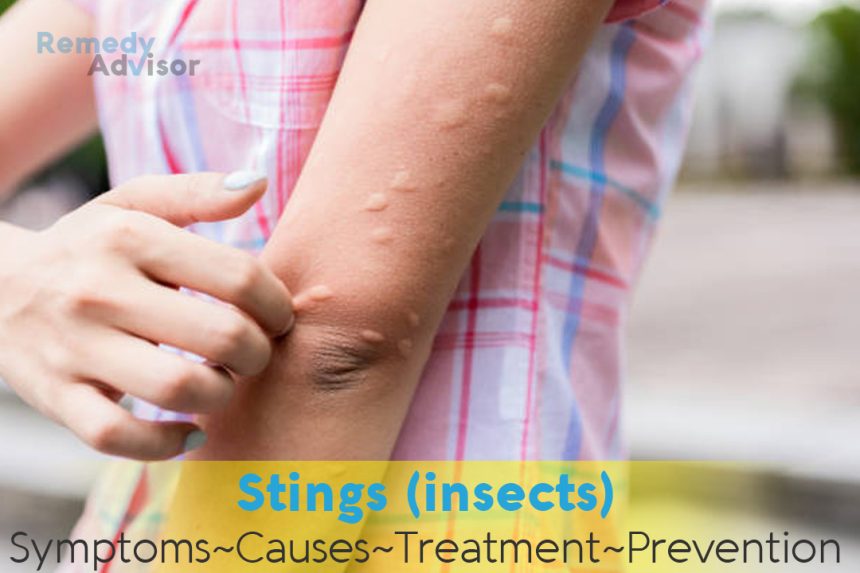What is it
Stings from bees, yellow jackets, hornets, wasps, and fire ants are a common occurrence during the summer months (year-round in warm climates). For most people the reaction to a sting is harmless (albeit, potentially painful). However, some people about 3 percent of the population are so sensitive to the venom that even one sting can provoke their immune system to overreact drastically. This is identified as anaphylactic shock (from the Greek ana, meaning extreme, and phylaxis, meaning defense); it include nausea, depressed blood pressure, flushing, vomiting, irregular heartbeat and difficulty breathing, and may lead to a coma and even death.
In fact, about 50 Americans die each year as a result of being stung by bees, wasps, or hornets. No other venomous animal, even snakes, kills that many. And this figure may be too low: experts suggest that an unknown number of deaths attributed to heart failure may actually be caused by stings.
Symptoms
- Burning, swelling, redness, and sometimes welts and itching in the area around the sting.
- Allergic reaction to stings: rapid swelling of the lips, tongue, throat, and eyes; nausea; irregular heartbeat; difficulty breathing; loss of consciousness. (Multiple stings can also produce the same symptoms.)
What causes it
The venom of these insects contains toxins that produce the fierce burning and swelling at the site of the sting. The cause of more severe allergic reactions to stings is not well understood. Anyone who has experienced any symptoms of anaphylactic shock or any systemic reactions after being stung should know that reactions usually become increasingly severe with successive stings. Life-threatening reactions most often occur in people over the age of 30.
What if you do nothing
In most people the pain and swelling from a single sting disappear after a few hours. If you are allergic, however, you should seek medical help, even if the reaction appears to be mild. Multiple stings can also produce a toxic reaction that requires immediate treatment.
Home remedies
For pain and swelling at the site of the sting, the following measures can help. (If you’re hypersensitive to stings, you should have a special emergency kit containing adrenaline whenever you’re outdoors. Also consider desensitization shots, especially if you spend a good deal of time outdoors in areas populated by bees.)
Start with soap and water
The best way to treat a sting is to wash it with soap and water. Applying an ice pack or flushing with cold water can also help relieve pain and reduce swelling.
Try tenderizer
You may also obtain some relief by applying calamine lotion or a paste made by mixing baking soda or unseasoned meat tenderizer and water. (The tenderizer contains papain, an enzyme that breaks down toxins in the venom.) Aspirin or another over-the-counter anti-inflammatory drug such as ibuprofen can also help alleviate pain.
Remove bee stingers at once
Conventional wisdom says that pulling a stinger from the skin with tweezers or fingers is a bad idea because it tends to inject more venom. Thus, standard advice has been to scrape the protruding venom sac away with a sharp blade and then remove the stinger (and to leave the stinger in until you can do this). However, in a recent study published in the ‘The Lancet’ bee stings swelled less and hurt less when the stinger was removed immediately by whatever method including pinching the stinger. (Beekeepers have known this for centuries, it seems.) If you are among the small percentage of people subject to anaphylactic shock, removing the stinger quickly can help save your life.
If you’re near a hive, retreat
As it stings, a honeybee releases a chemical that identifies you and draws other bees. So if you’ve been stung close to a hive, hurry to a safe place.
Prevention
You can avoid being stung by taking a few preventive measures:
Dress for protection
Wear shoes and socks outdoors; don’t go barefoot. When gardening, wear a long-sleeved shirt, long pants, and gloves. Bees can mistake you for flowers, so avoid brightly colored clothes and floral prints.
Spray yourself
It helps to apply insect repel lent on exposed skin, trouser and sleeve cuffs, and shirt fronts. Avoid wearing sweetly scented perfumes, soaps, or lotions.
Be cautious about eating outside
Bees are particularly attracted to sweet, drippy foods like ice cream or watermelon.
Don’t try to fight
If an insect is annoying you, don’t swat it either walk away or, if attacked by a swarm, lie down and cover your head.







